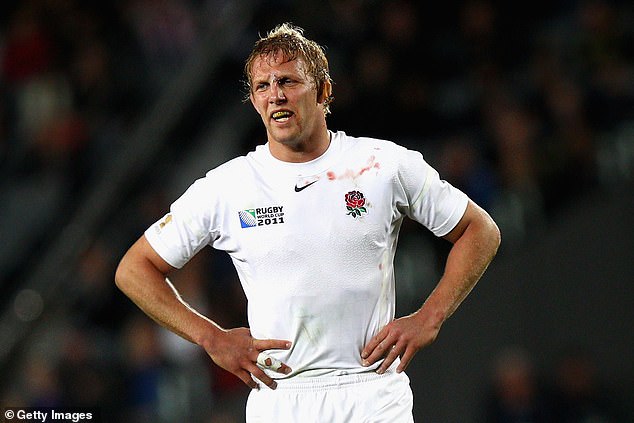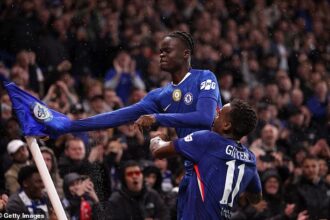When Doddie Weir was diagnosed with motor neurone disease (MND) in 2016, little was made of links between the debilitating condition and rugby.
The Scotland legend, who made 61 caps for his country and appeared in two World Cups, was the first high-profile player to suffer from the illness, which has been described by the NHS as ‘usually life-shortening’.
From the moment he told the world of his diagnosis to his death in 2022, Weir made it his mission to raise awareness for the disease, raising significant funds to aid research into it.
Nine years on, the connection between rugby and MND is more concerning than ever.
On Monday, 2003 World Cup winner Lewis Moody confirmed that he had become the fourth former international rugby player to be told they are suffering from the rare disease that causes cells in the body to deteriorate over time.
Moody’s former team-mate Ed Slater, whom he played with at Leicester Tigers, was forced into early retirement from the sport in 2022 after also being diagnosed with the illness. Weir and Rob Burrow, a rugby league icon, both died after battling MND.
Ex-England star Lewis Moody confirmed he has been diagnosed with motor neurone disease


Moody becomes the fourth high-profile rugby star to suffer from the disease, with both Doddie Weir (left) and Rob Burrow (right) passing away due to it

Moody, pictured alongside his wife Annie, opened up about his diagnosis on Monday morning
Questions are now being asked. Why are so many retired rugby players getting MND?
During the year of Weir’s death, a study conducted by the University of Glasgow, led by Dr William Stewart, discovered that former international rugby union players were 15 times more likely than regular people to be impacted by MND during their lifetime.
Published in the Journal of Neurology, Neurosurgery and Psychiatry, the study compared 412 male former Scotland internationals, all over the age of 30, with 1,200 or more individuals from the general population.
Speaking in 2022, following his research, Stewart said: ‘Of particular concern are the data on motor neurone disease risk among our rugby players, which is even higher than that for former professional footballers.
‘This finding requires immediate research attention to explore the specific association between rugby and the devastating condition of motor neurone disease.’
Awareness of the disease has skyrocketed ever since Weir revealed he was battling the condition. He was a giant of the game, a player remembered for being both an elite-level lock and a bubbly personality.
He used his status within the sport as a platform to launch the My Name’5 Doddie foundation in 2017, which worked tirelessly to improve care for those affected by MND.
Since its inception, it has raised nearly £20million to fund research into the disease, and in 2025 alone, it has committed £1.35m to ‘cutting-edge motor neuron disease (MND) research projects’, after thousands of people travelled over one million miles via various modes of exercise during a fundraiser in memory of Weir.

A study in 2022 discovered that former international rugby union players were 15 times more likely to get MND than regular people
His efforts toward motor neurone disease research, as well as his services to rugby, led to Weir being awarded an OBE in 2019.
My Name’5 Doddie Foundation recently partnered with Dr Stewart, funding research – alongside the MND Association and MND Scotland – into potential links between MND and traumatic brain injuries (TBI).
The study used health records from over 340,000 adults in the UK and determined that people ‘with a history of TBI’ were two times more likely to be diagnosed with MND than individuals who hadn’t been subjected to a TBI. The findings were based on the initial two years after such injury.
‘These observations highlight the very complex relationship between head injury and risk of MND,’ Stewart said. ‘The possibility that TBI might be an early indicator of developing MND is an important finding and might suggest increased surveillance in highest risk patient populations may be of benefit.’
Burrow, or the ‘Mighty Atom’ as he was known as by Leeds Rhinos fans who adored him, was the second international rugby star to reveal he had been diagnosed with MND, back in 2019.
The scrum-half, and occasional hooker, enjoyed a fruitful 17-year career in the sport – with the entirety of it spent at the Rhinos – laden with silverware. Two years after retirement, though, he was given the shocking news that he had just two years to live.
‘Like an athlete, I would tackle the challenge head-on,’ Burrow said after learning of his diagnosis, and that was exactly what he did.
He would raise more than £15m, with his long-standing friend and former Rhinos’ captain Kevin Sinfield, during the five years between his diagnosis and his death. Like Weir, he built a legacy through his efforts to raise awareness for the disease., and was awarded an MBE in 2022.

Rob Burrow and his long-standing friend Kevin Sinfield (right) raised over £15m to aid research into the disease

The Rob Burrow Centre for Motor Neurone Disease is being built and is due to open before the end of the year

Moody’s former Leicester Tigers team-mate Ed Slater was diagnosed with MND in 2022 and is now leading the fight in rugby against the disease
Sinfield undertook a series of extreme endurance challenges, including a series of ultramarathons for Burrow, to raise funds in his name.
Before he died, Burrow had raised £6m in order to build a specialist facility to provide space for MND services. Construction on the The Rob Burrow Centre for Motor Neurone Disease, which is the first of its kind, began the day after Burrow’s death last year, and is expected to be completed and functioning by the end of 2025.
Slater, like Burrow and Weir before him, now leads the way in the fight in rugby to raise awareness for MND, following his diagnosis three years ago, which came after six months of testing.
As he told TNT Sports in 2023, ‘I’m still here’, and the former second row is determined to keep shining a light on the condition. Following his diagnosis, he established the 4Ed Foundation, which operates as part of the Gloucester Rugby Foundation, the team he played for upon his retirement.
Moody will now join his former team-mate in the charge to tackle the incurable disease, as the sport continues to do its bit in raising millions in funds in order to find a cure.
The signs that there is a link between the sport and the condition are becoming increasingly hard to ignore, and Moody’s diagnosis has only increased calls for more research into the affiliation between them.
However, Professor Ammar Al-Chalabi of King’s College London, who is addressing the issue ‘with the biggest study of its kind’, has stated that there is no certainty that playing rugby causes MND.
‘As things stand, we cannot say for certain that regularly playing rugby – or any other sport – as a professional or simply with friends at the weekend causes MND,’ Al-Chalabi told the Daily Mail.

One expert from King’s College London has said there is no certainty that playing rugby causes MND
‘It may seem from the headlines that there is an obvious heightened risk.
‘But the fact is, one in 300 of us will get this destructive and irreversible illness (MND kills a third of people within a year and more than half within two years of diagnosis) – it’s just that most cases never make the media spotlight.
‘And the research results are mixed; some studies, for example, suggest professional footballers may also be more likely to develop MND (up to six times more likely according to some research) than the general population.
‘But others have found no such association.’










